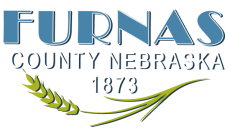About Our County
Demographics
- Land Area: 721 mi2
- Population (2020): 4,636
- Towns and Population (2020)
- Cambridge: 1,071
- Arapahoe: 1,002
- Oxford (partial): 718
- Beaver City: 537 (County Seat)
- Holbrook: 201
- Edison: 111
- Wilsonville: 75
- Hendley: 20
History of Furnas County
The pride and enthusiasm that early settlers placed in locating the seat of local government was possibly nowhere more evident than in Furnas County. Events there showed just how strong the emotions could become.
When Robert W. Furnas became governor in 1873, the Legislature adopted an act to organize an area along the Kansas border and name this latest county in his honor. The influx of settlers that had preceded the Legislature’s action had already resulted in the settlements of Arapahoe and Beaver City being established. So when the county’s first organization election was held on April 8, 1873, ballots were cast at both sites.
Election results from Arapahoe were filed with the Secretary of State’s office within the appointed time limit. The returns from Beaver City, however, were delayed en route to Lincoln because of a heavy snowstorm. As a result, Beaver City’s ballots did not arrive until after the day on which the ballots were counted. The Secretary of State issued certificates of election of officials in Arapahoe and ruled that settlement to be the county seat. What followed was a series of court orders and bitter political fights between the settlers in the north and south parts of the county.
A court quickly ordered the Secretary of State to canvass the Beaver City votes and issue certificates of election to the candidates who received the highest vote from the combined returns of Arapahoe and Beaver City, and to designate as the county seat the site that received the greatest vote
A second election was held the following October. This time, Beaver City was declared the victor. Inhabitants of Arapahoe continued to claim victory based on the April election. It took three years of legal challenges before the Supreme Court ruled that Beaver City was indeed the county seat. Continued dissention delayed the building of a courthouse until 1888.
The first courthouse stood for 60 years before being declared unsafe for occupancy in 1948. The courthouse was dismantled the following year and after the county offices were housed in various downtown buildings for two years, the current courthouse was dedicated on May 4, 1951
General George A. Custer Traveled through Furnas County in June of 1867
- June 1, 1867 – General Custer, with 350 men and 20 supply wagons left Ft. Hays, KS to search for Indians between Ft. Hays and the Platte River in Nebraska.
- June 6 – They entered into Furnas County at a spot on the Nebraska-Kansas line south of the present town of Hendley and one mile east.
- They traveled northwest about one mile to find a place to cross the “Stealing Horse Creek” (Sappa Creek). This crossing is straight south of Hendley.
- They proceeded northwesterly to the “White Rock Creek” (Beaver Creek), at a spot about two miles west of Hendley.
- Here they found an Indian Trail indicating about 15 Indians going east but they didn’t follow it as the trail was several days old.
- They forded the creek and proceeded northwesterly to within two miles of the Republican River and camped there over night.
- June 7 – They continued a northwesterly route to the east side of Medicine Creek and followed it north going out of Furnas County the same day.
- They traveled on to Ft. McPherson on the Platte River, then traveled back to Kansas in a southwesterly direction and then into eastern Colorado.
- July 12 – They returned back to Ft. Wallace, located on the south fork of the Smokey Hill River in western Kansas.
- They had several skirmishes with Indians, but nothing of great importance was really accomplished.
- June 5, 1967 – As part of Nebraska’s Centennial Celebration, almost 100 years to the day from Custer’s crossing of the Beaver Creek, a wagon train composed of 5 wagons and some 40 people under the leadership of Wagon-master, Lyle Hutchens of Hendley, started out from the Hutchens farm near Hendley and crossed the Beaver Creek at almost the exact crossing location taken by General Custer in 1867.
